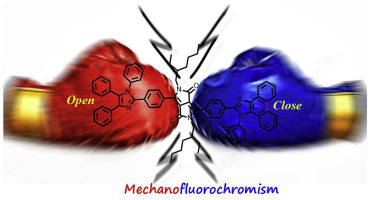Dyes and Pigments ( IF 4.1 ) Pub Date : 2019-02-05 , DOI: 10.1016/j.dyepig.2019.02.009 Qikun Sun , Kai Zhang , Xiaojing Fan , Liangliang Tang , Linxi Liu , Yanhui Wang , Qi Ding , Min Zhai , Shanfeng Xue , Wenjun Yang

|
Subtle modification on molecular structure can play a crucial role in determining solid-state fluorescence properties and stimuli-responsive behaviors. In the current work, we utilize the condensation reactivity of benzaldehyde attached at the periphery of 1,4-diketopyrrolo[3,4-c]pyrrole (DPP) with benzil and phenanthrene-9,10-dione to design and synthesize two new DPP-centered A′‒A‒A′-type dyes (DPPBI and DPPPI), and they can be regarded as the analogues with and without the locked two peripheral phenyls. DPPBI and DPPPI show similar solution optical properties, however, their pristine solids emit bright yellow (570 nm) and near-infrared (NIR, 685 nm) fluorescence, respectively, indicating that the tiny structure change can induce a remarkable aggregate emission difference up to 115 nm. Moreover, when mechanically grinding the pristine solids, both ground states emit the red fluorescence with slightly different peak wavelengths of 615 nm for DPPBI and 623 nm for DPPPI, revealing that DPPBI and DPPPI are all mechanofluorochromice (MFC) dyes but exhibit the opposite MFC shift direction. These dichotomy emission and MFC behaviors are analyzed and discussed and demonstrate that subtle manipulation on molecular end groups can acquire unique aggregation emission and stimuli-responsive behaviors.
中文翻译:

巧妙地操纵以DPP为中心的染料的端基结构,以实现多种聚集荧光和刺激响应行为
分子结构上的细微修饰可以在确定固态荧光特性和刺激响应行为中发挥关键作用。在当前工作中,我们利用附着在1,4-二酮吡咯并[3,4-c]吡咯(DPP)周围的苯甲醛与苯甲腈和菲-9,10-二酮的缩合反应性来设计和合成两种新的DPP中心的A'‒A‒A'型染料(DPPBI和DPPPI),它们可以被视为带有和不带有两个锁定的周边苯基的类似物。DPPBI和DPPPI表现出相似的溶液光学性质,但是,它们的原始固体分别发出亮黄色(570 nm)和近红外(NIR,685 nm)荧光,这表明微小的结构变化可以诱导高达50nm的显着聚集体发射差异。 115 nm。此外,当机械研磨原始固体时,两种基态发出的红色荧光的DPPBI峰值波长分别为615 nm和DPPPI 623nm,略有不同,这表明DPPBI和DPPPI均为机械荧光染料(MFC)染料,但具有相反的MFC移位方向。这些二分法发射和MFC行为进行了分析和讨论,并证明对分子端基的微妙操纵可以获得独特的聚集发射和刺激响应行为。















































 京公网安备 11010802027423号
京公网安备 11010802027423号